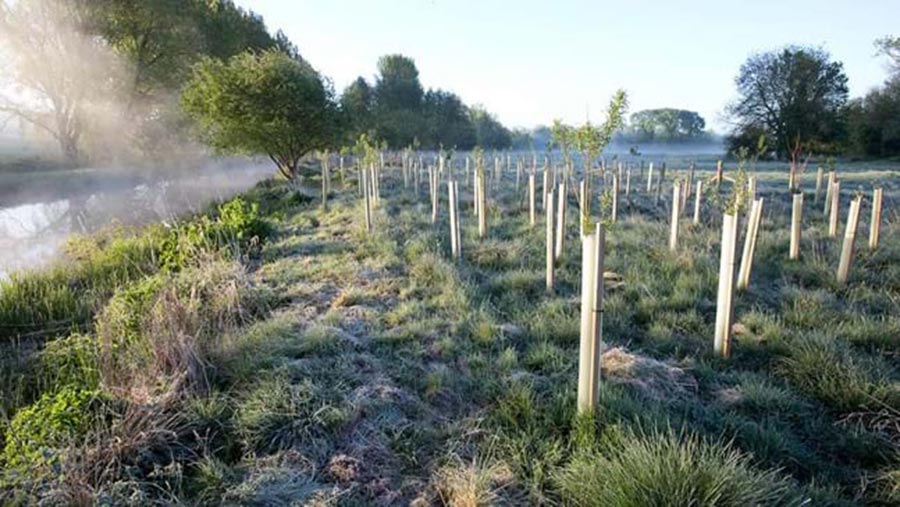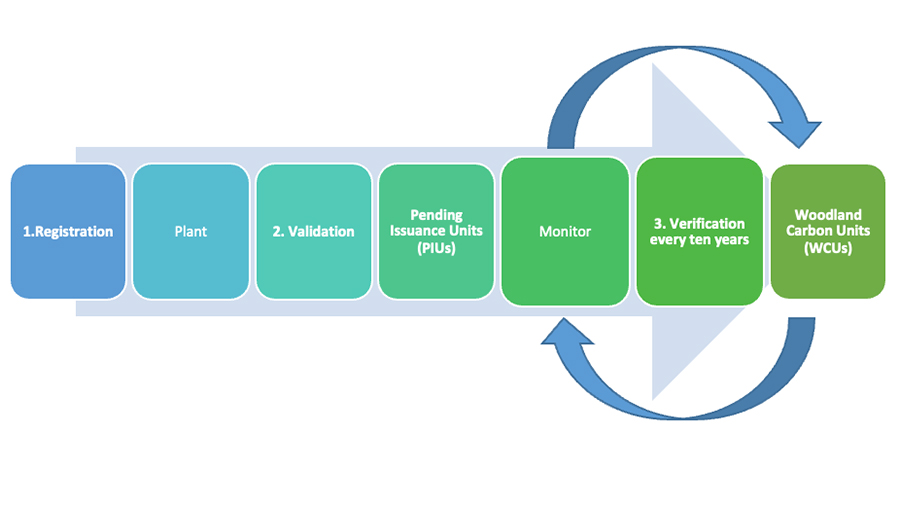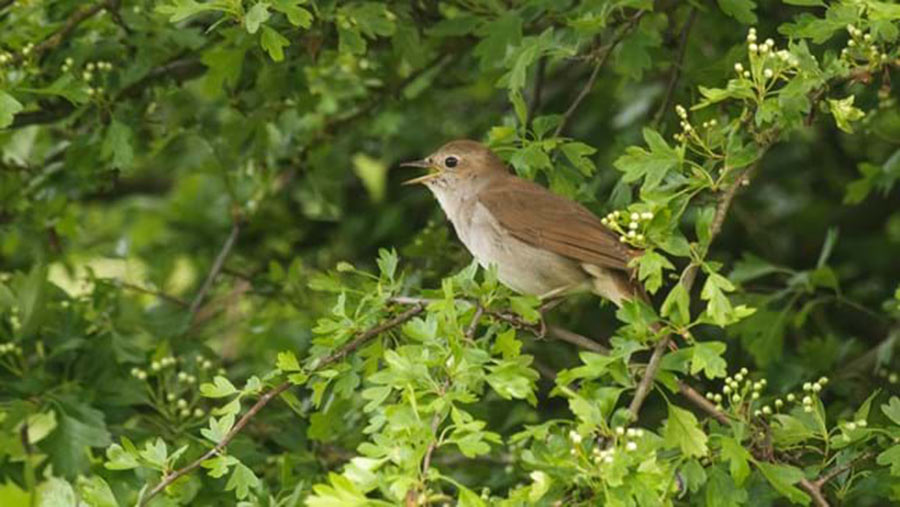Advertiser content
How to make the most of carbon units with tree planting
New woodland carbon schemes are constantly popping up and if you’re considering selling carbon units sequestered from planting trees, it can be difficult to know how to get started and what to consider.
Integrating trees into farming systems has the potential to deliver multiple benefits for production, resilience and the environmental sustainability of your business – it’s all about putting the right tree in the right place.
Understandably, farmers want to get the best possible price while having the least impact on productive land.
Acting now is key, so here’s what you need to know if you’re considering planting trees on your land to make money from carbon.

© Edward Parker/WTML
Timing is everything
Although the price of carbon units being sold by farmers and landowners is variable from scheme to scheme, getting the timing right is essential.
With the Government’s target of corporates being net zero by 2050 fast approaching, starting a scheme now is going to be the most lucrative.
Woodland Carbon Code (WCC) schemes must be registered before planting. Once a project is planted, it is validated and an estimate of how much carbon will be sequestered is made.
The process itself can take over a year and often longer where a farmer is waiting for a woodland creation grant application to be processed.

*Diagram shows the process for a woodland carbon scheme delivered under the Woodland Carbon Code.
The catch for corporates is that they are not able to declare that they are Net Zero until they have actual WCUs, but native broadleaf trees for example, take an average of 25 years to start sequestering carbon at peak rates.
Add this 25 years to today’s date and you’re almost at 2050 – the Government’s Net Zero target.
This means WCUs ready by 2050 will be the most in demand, meaning that in turn, projects planted by 2025 will likely have the most valuable units to sell.
Example of predicted sequestration and conversion from PIUs to WCUs for a 1ha native broadleaf scheme |
|||||
|
Verification: years since start date |
Vintage Start Date |
Vintage End Date |
Total PIUs in vintage to be listed (tCO2e) |
PIUs to Buffer (tCO2e) |
PIUs to Project (tCO2e) |
|
5 |
01 April 2023 |
31 March 2028 |
0 |
0 |
0 |
|
15 |
01 April 2028 |
31 March 2038 |
46 |
9 |
37 |
|
25 |
01 April 2038 |
31 March 2048 |
138 |
28 |
110 |
|
35 |
01 April 2048 |
31 March 2058 |
83 |
16 |
67 |
|
45 |
01 April 2058 |
31 March 2068 |
48 |
10 |
38 |
|
55 |
01 April 2068 |
31 March 2078 |
37 |
7 |
30 |
|
65 |
01 April 2078 |
31 March 2088 |
29 |
6 |
23 |
|
75 |
01 April 2088 |
31 March 2098 |
24 |
5 |
19 |
|
85 |
01 April 2098 |
31 March 2108 |
16 |
3 |
13 |
|
95 |
01 April 2108 |
31 March 2118 |
10 |
2 |
8 |
|
100 |
01 April 2118 |
31 March 2123 |
5 |
1 |
4 |
|
Total |
|
|
436 |
87 |
349 |
| *Taken from the Woodland Carbon Code Calculation Spreadsheet V2.4 Tool [available at: woodlandcarboncode.org.uk/standard-and-guidance/3-carbon-sequestration/3-3-project-carbon-sequestration] and assuming 1ha of mixed broadleaf planting. | |||||
As you can see, peak sequestration rates occur over the first 45 years of the project with 72% of PIUs converting to WCUs over this period.
Though in this example the majority of units will mature after the 2050 Net Zero deadline.
Get to grips with the finances
Farmers are faced with a range of options for developing woodland creation schemes and selling units produced under WCC projects.
There is often significant focus on the headline price achieved for units, but landowners will also need to understand the costs involved with developing their scheme.
Typical costs may include a combination of third-party validation and verification audit costs, project developer fees, WCC costs and brokerage commission.
Costs will vary between project developers and may have a significant impact on a project’s net income, so being informed from the start is vital.
Be realistic
Once a scheme is validated and a carbon sequestration estimation made, the landowner has committed to delivering those Woodland Carbon Units.
If the PIUs don’t convert into as many WCUs as initially thought, the landowner still needs to deliver, essentially sourcing them from elsewhere.
This can result in a loss in income for the landowner if the units they need to buy are more expensive than the ones they are selling, hence the importance of having an accurately measured scheme initially.
A WCC buffer does offer some protection against unavoidable losses, but the risk should still be reduced at the validation stage.

© John Bridges/WTML
Right tree, right place
When it comes to woodland design, remember that carbon sequestration is just one potential advantage.
Trees on farmland can increase soil infiltration and water retention to fight flooding as well helping prevent nitrate leaching and soil erosion, both of which impact water quality.
Trees in fields, hedges and shelterbelts can boost welfare and livestock performance, helping to reduce infant mortality rates and improve the condition of adult stock.
Tree shelter in hedgerows and belts also supports early and late season grass growth by raising soil temperatures in early spring and late autumn.
Interested in exploring a Woodland Carbon scheme?
The Woodland Trust has a wealth of experience when it comes to advising farmers on how to make the best of your trees. We offer free no-obligation advice covering what trees to plant, where and when.
We can also help identify what grants might be available to you, not only from us, but also from external funders, in order to get your woodland carbon scheme going.
Our Woodland Carbon scheme application is simple and as an added bonus, we cover all WCC associated costs. We’ll deal with all the paperwork and provide 70% of the total funds estimated to be generated by your scheme at validation stage.
To find out more about our scheme, visit woodlandtrust.org.uk/plant-trees/woodland-carbon-farmers-and-landowners/ or to speak to an adviser, email carbon@woodlandtrust.org.uk or call 034307705740.
The Woodland Trust is a registered charity, numbers 294344 and SC038885. A non-profit making company limited by guarantee. Registered in England No. 1982873. Registered Office: Kempton Way, Grantham, Lincolnshire, NG31 6LL. The Woodland Trust logo is a registered trademark.
Provided by
Trees can maintain or even enhance the farm’s main agricultural output while improving the resilience of the business and simultaneously helping to protect soils, rivers, biodiversity, and climate.
Systems can be designed to avoid the potential trade-offs that occur in many modern farming systems between food production and public goods, like clean air.
How can the Woodland Trust help
Our advice and funding can help you to integrate trees into your farming system. With a bespoke plan designed for your individual business, we can offer up to 100% funding.
For more information on the funding available, please visit:
Tree planting – Woodland Trust
For more information on agroforestry, please visit:
